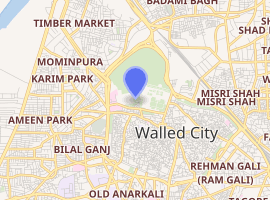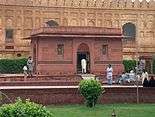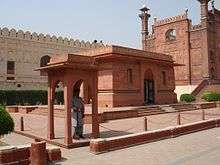Tomb of Allama Iqbal
The Tomb of Allama Muhammad Iqbal, or Mazaar-e-Iqbal (Urdu: مزار اقبال) is a mausoleum located within the Hazuri Bagh, in the Pakistani city of Lahore, capital of Punjab province.
| Tomb of Allama Iqbal | |
|---|---|
(Urdu: مزار اقبال ; Mazaar-e-Iqbal) | |
Mausoleum with Badshahi Mosque in the background | |

| |
| General information | |
| Type | Mausoleum |
| Architectural style | Mughal |
| Location | Lahore, Punjab
|
| Design and construction | |
| Architect | Nawab Zain Yar Jang Bahadur |
Background
Iqbal was one of the major inspirations behind the Pakistan Movement, and is revered in Pakistan as Muffakir-e-Pakistan (The Thinker of Pakistan) or Shair-e-Mashriq (The Poet of the East).[1] Iqbal died on 21 April 1938 in Lahore at the age of 60. Thousands of visitors come to the mausoleum every day to pay their respects to the poet-philosopher.[2] It is said that Mustafa Kemal Atatürk sent earth collected from Maulana Rumi's tomb to be sprinkled on this grave[3]
History
Soon after Iqbal's death in April 1938, a committee was formed that was presided over by Chaudhary Mohammed Hussain.[4]
A major problem in the realisation of this monument was a lack adequate funds. The committee resolved not to accept any donations from the local governments and state rulers, and so funds were raised through the contributions from Iqbal's friends, admirers and disciples.[5]
Architecture
The architecture has a combination of styles however it reflects mainly the Mughal style. The structure is entirely constructed of red sandstone,[6] which was brought from Jaipur, British India, and building marble from Makrana, Rajputana. After the independence of Pakistan in 1947, construction was affected due to export restrictions of red stone from India. Six couplets of a ghazal are carved from Iqbal's poetical work Zabur-e-Ajam (Persian Psalms) on the mausoleum's interior surfaces.[7] Outside, there is a small garden, distributed into small plots. The mausoleum was designed by Hyderabad Deccan's then Chief Architect, Nawab Zain Yar Jang Bahadur and took thirteen years to build at a cost of about one hundred thousand (Rs. 100,000) Pakistani rupees. The major reason for delay was the stoppage of red-stone from Jaipur in post-independence India.[3]
Grave and cenotaph
The rectangular mausoleum has two gates at the eastern and southern side respectively, inlaid with marble, while the cenotaph itself is made of white marble. The tombstone was a gift from the people of Afghanistan, and is made of lapis lazuli and inscribed with Quranic verses in calligraphy inscribed in Afghanistan.
Conservation
The tomb complex is listed on the Protected Heritage Monuments of the Archaeology Department of Punjab.[8]
Gallery
 North wall of the mausoleum
North wall of the mausoleum South East side of the mausoleum
South East side of the mausoleum Inside Iqbal's mausoleum, a marble cenotaph
Inside Iqbal's mausoleum, a marble cenotaph Guard at the mausoleum, with Lahore Fort in background
Guard at the mausoleum, with Lahore Fort in background Iqbal's mausoleum adjacent to the Badshahi Mosque's gateway
Iqbal's mausoleum adjacent to the Badshahi Mosque's gateway- Tomb of Muhammad Iqbal
See also
- Tomb of Asif Khan
- Tomb of Jahangir
- Tomb of Nur Jahan
- Architecture portal
- Iqbaliat
- Category:Iqbal scholars
- List of mausolea
References
- Annemarie Schimmel, Muhammad Iqbal 1873–1938: The Ascension of the Poet, Die Welt des Islams, New Ser., Vol. 3, Issue 3/4. 1954. pp. 145–157
- Mushirul Hasan, H., A Nationalist conscience: M. A. Ansari, the Congress and the Raj, Manohar New Delhi. 1987
- Iqbal’s final resting place, Amna Nasir Jamal, 20 April 2002, Dawn
- Muhammad Baqir, Lahore, Past and Present. University of the Panjab. Panjab University Press. 1952. p.429
- A great eastern poet, philosopher, Subhash Parihar, The Tribune India, 10 July 1999
- Mohammad Waliullah Khan, Lahore and Its Important Monuments, Department of Archaeology and Museums, Government of Pakistan. 1964. p.89-91
- Annemarie Schimmel, Islam in the Indian Subcontinent (Handbuch Der Orientalistik), Brill. 1980. ISBN 978-90-04-06117-0
- Pakistan Environmental Protection Agency. "Guidelines for Critical & Sensitive Areas" (PDF). Government of Pakistan. pp. 12, 47, 48. Archived from the original (PDF) on 14 October 2013. Retrieved 6 June 2013.
External links
| Wikimedia Commons has media related to Tomb of Allama Iqbal. |